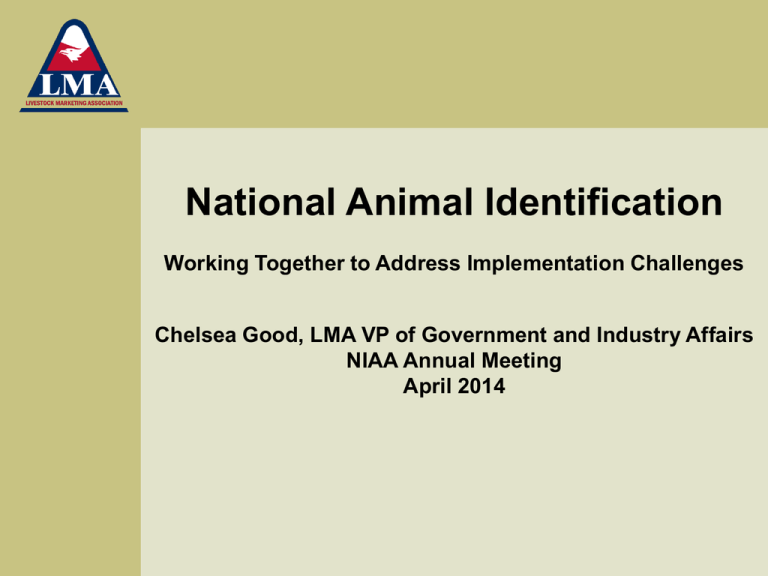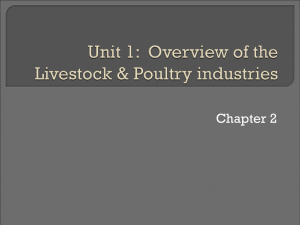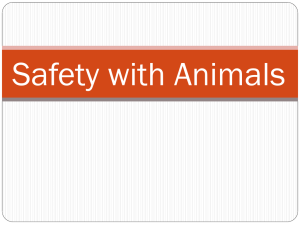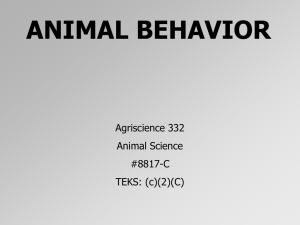Update on Livestock Markets and Animal Identification
advertisement

National Animal Identification Working Together to Address Implementation Challenges Chelsea Good, LMA VP of Government and Industry Affairs NIAA Annual Meeting April 2014 Who is LMA? National Trade Organization for livestock marketing businesses LMA represents 70 % of the regularly selling livestock markets in the U.S.A. (regularly selling = at least one sale per week) Junction between buyers and sellers Livestock Owners Livestock Markets Livestock Buyers Where are our 800+ members located? ADT Implementation Challenges from April 2013 Education Producer Access to Tags Transportation Documents Database Use Dairy Steers Education Much accomplished over last year, but still room to grow Producer Education •Including markets but not relying on them as sole source of communication. Education and training within regulatory staff Animal Disease Traceability (ADT) Differences between states based on flexibility built into rule •State implementation survey prior to August 2013 USAHA/NIAA forum on ADT in Denver Other states requirements still apply Some state have promulgated state identification requirements at same time Tagging Sites Can accept out-of-state animals not yet identified Most states entering agreements with markets (and others) to be tagging sites • Survey indicated 37 of 41 states preparing to provide for approved tagging sites Strong preference for single-issue agreements Documentation Options Owner Shipper Statement Exception Cattle requiring official ID may move across state lines directly to an approved livestock facility prior to being identified and without a health certificate if moved on an owner shipper statement. Alternative Documentation Cattle requiring official identification must have an Interstate Certificate of Veterinary Inspection (ICVI), commonly called a health certificate, or alternate documentation agreed on by the states, to move across state lines. Looking Forward – Enforcement March 4 – USDA APHIS administrator Kevin Shea sent out a bulletin about the next phase ADT implementation • USDA will begin exercising and testing the system in March • USDA will then work with people not in compliance to educate them about the requirements. • However, USDA will also pursue penalties in situations where an individual repeatedly fails to comply with the regulatory requirements. Looking Forward – Enforcement USDA-Identified Priorities 1. Official Identification of Cattle 2. Proper Administration of Interstate Certificates of Veterinary Inspection (ICVI) 3. Collection of ID at Slaughter USDA will address ADT compliance with existing staff. Cases will begin with the Area Vet in Charge initiating a case to be followed up on by USDA’s Investigative Enforcement Services. Looking Forward – Enforcement Under the Animal Health Protection Act of 2002, APHIS is able to assess a wide range of monetary civil penalties. In extreme cases, criminal penalties are also available. Who is responsible? 9 CFR § 86.2(b) “No person may move covered livestock interstate or receive such livestock moved interstate unless the livestock meet all applicable requirements of this part.” “ADT monitoring and compliance” document being finalized and will be shared publically. Looking Forward – Enforcement Consistency in enforcement is key. How will enforcement of ADT, and other animal health requirements, be consistently enforced against all regulated entities regardless of method of sale? Any Questions? Chelsea Good, LMA VP of Government and Industry Affairs cgood@lmaweb.com 816-305-9540 Animal Disease Traceability (ADT) General requirements For cattle, the following animals must be identified with official ID if traveling in interstate commerce: •All sexually intact cattle and bison over 18 months of age, •All female dairy cattle of any age, •All dairy males (intact or castrated) born after March 11, 2013, and •Cattle and bison of any age used for rodeo, shows, exhibition, and recreational events. This rule only applies to cattle moving from one state to another and not those staying in state. Animal Disease Traceability (ADT) Health Certificate Recording Cattle requiring official identification must have an Interstate Certificate of Veterinary Inspection (ICVI), commonly called a health certificate, or alternate documentation agreed on by the states, to move across state lines. Generally, the official identification number of cattle must be recorded on this document. However, this is not required for cattle moving from an approved livestock facility directly to slaughter or dairy steers under 18 months of age. Animal Disease Traceability (ADT) What changes did comments generate between the proposed rule and final rule? • Accepting the use of brands, tattoos and brand registration as official identification when accepted by the shipping and receiving States or Tribes • Permanently maintaining the use of backtags as an alternative to eartags for cattle and bison moved directly to slaughter • Accepting movement documentation other than an Interstate Certificate of Veterinary Inspection (ICVI) for all ages and classes of cattle when accepted by the shipping and receiving States or Tribes • Beef cattle under 18 months of age are exempted, unless they are moved interstate for shows, exhibitions, rodeos, or recreational events • USDA intends to address in separate rulemaking National Animal Identification System









